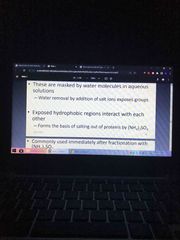![]()
![]()
![]()
Use LEFT and RIGHT arrow keys to navigate between flashcards;
Use UP and DOWN arrow keys to flip the card;
H to show hint;
A reads text to speech;
27 Cards in this Set
- Front
- Back
- 3rd side (hint)
|
Principle of Adsorption chromatography Separation is based on |
Adsorbents hold molecules on their surfaces at specific adsorption sites via Van der Waal forces H bonding
Separation is based on differences in binding strengths—- this depends on binding groups —- OH and aromatic groups (increase interaction with binding surface ). Aliphatic groups of diff sizes( differ only slightly in their interaction ) |
|
|
|
Alumina and carbon adsorbents are good for separation of what materials |
Acidic materials |
|
|
|
Silica gel has what absorbent binding group |
OH |
|
|
|
What type of mobile phase is chosen when the analyte has OH groups |
An alcohol |
|
|
|
What m phase is used when analyte has carbonyl groups |
Acetones or esters |
|
|
|
What m phase is chosen when analyte is non polar |
Hydrocarbons like hexane, heptanes and toluene |
|
|
|
Applications of adsorption chromatography |
Used to separate non ionic, water insoluble, compounds eg; TAGs, amino acids, vitamins and many drugs |
|
|
|
What is hydroxyapatite |
An adsorbent used in separation of mixtures, proteins and nucleic acids Hydroxyapatite chromatography |
|
|
|
Mechanisms of hydroxyapatite chromatography |
Involves the presence of calcium and phosphate ions at the surface where Dipole dipole interactions and electrostatic attractions occur. |
|
|
|
Applications of Hydroxyapatite chromatography |

High affinity of hydroxyapatite for double stranded DNA cause it’s selective removal from RNA and proteins |
|
|
|
Hydrophobic interaction chromatography |

Used to purify proteins by exploiting their surface hydrophobicity. |
|
|
|
Two main types of adsorption chromatography |
Hydroxyapatite chromatography Hydrophobic interaction chromatography HIC |
|
|
|
Drawback of the hydrophobic interaction chromatography |
Some of the elation conditions may cause protein denaturation |
|
|
|
Partition chromatography principle |
Based on differences in capacity ratios and distribution coefficients Kd of analyses using liquid stationary and mobile phases |
|
|
|
Subdivisions of partition chromatography |
Liquid liquid chromatography |
Bonded phase liquid chromatography |
|
|
Liquid liquid chromatography And it’s advantages and disadvantages |
Stationary phase( usually water) is supported by a cellulose starch or silica matrix
Advantages Cheap High capacity Broad selectivity
Disadvantage Elution process may remove stationary phase
|
|
|
|
Bonded phase chromatography |
Uses silica as matrix Immobilizes the stationary phase by reaction with an organichlorosilane |
|
|
|
Two commonly used modes of partition chromatography based on differing relative polarities of m and s phase |
Normal phase liquid chromatography Reverse phase liquid chromatography |
|
|
|
Normal phase liquid chromatography |
Stationary phase is polar Alkylamine bonded to silica mobile phase is non polar Hexane, heptane, dichloromethane and ethyl acetate |
|
|
|
Advantage of normal phase liquid chromatography |
It can separate analyte a with low water solubility and analyte a that are unfit for the reverse phase |
|
|
|
Reverse phase liquid chromatography |
S phase is non polar- silica with alkylsilane groups attached M phase is polar - water or aqueous buffers, methanol, acrylonitrile, tetrahydrofuran mixtures Small changes to m phase affects a lot. Changes like; Adding salt Changing ph Amt of organic solvent |
|
|
|
Order of elution in normal liquid chromatography |
Non polar elites first Polar, last |
|
|
|
Order of elation in reverse chromatography |
Polar elutes 1st Non polar, last
Non polar analytes may need gradient elution |
|
|
|
Uses of reverse liquid chromatography |
HPLC: analysis of drugs metabolites, pesticide m, residues and amino acids
FPLC: protein analysis |
|
|
|
Ion exchange chromatography principle |
Relies on attraction between oppositely charged particles |
|
|
|
Types of ion exchangers. Explain them |
Cation exchangers Have negatively charged groups that attract positively charged ions Anion exchangers Have positively charged groups tat attract negatively charged ions |
|
|
|
Ion exchange mechanism -5 Steps |
Diffusion of ion to the exchange surface Diffusion of ion through the matrix structure of exchanger to exchange site Exchange of ions at exchange site Diffusion of ion through exchanger to the surface Selective desorption by eluent and diffusion of molecule into effluent. |
|

